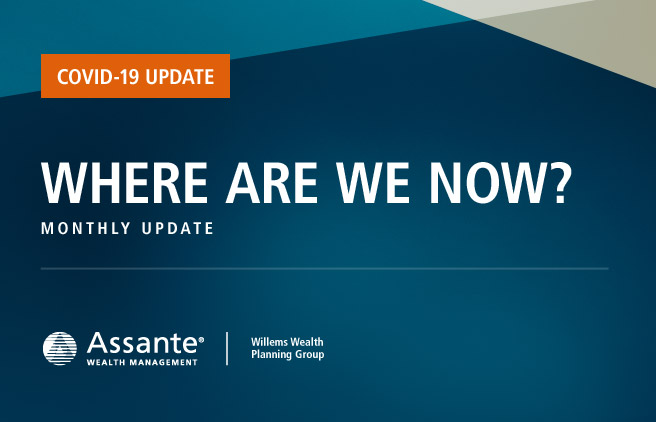
The COVID-19 Pandemic – Where Are We Now?
First and foremost, we hope you and your family are doing well. In many ways the COVID-19 pandemic has been a frustrating thing to go through, whether you are a child not able to see friends at school, an individual who lost a job or feels uncertain, a business owner facing unprecedented challenges, a parent who needs to look after their child(ren) while also working from home, or a portfolio manager like ourselves navigating volatile market conditions. However, as major market swings have started to stabilize and plans are announced for economies to reopen, we are all hopeful this will end soon.
The outbreak of COVID-19 is one of the most severe global health and economic conditions in history, and unfortunately, it is not over yet. New cases are expected to emerge, albeit likely at a lower growth rate, into the near future. Capital markets initially reacted to large-scale business shutdowns with very large sell offs in every sector, geography and asset class, including government bonds, but stabilized after some unprecedented government and central bank stimulus. As a result, April was one of the best months for stock performance in history. With trillions of dollars already spent, governments and central banks have saved the balance sheets of many individuals and businesses for the time being. However, their income requires the return of economic activities, which remains uncertain and will vary sector to sector. For example, Air Canada projects it will take at least three years for their business to return to normal. It is not a matter of cost, but a matter of motivating consumers and their comfort level with returning to a lifestyle similar to before, something that is unlikely to be turned on and off like a switch.
On the investment side, our short-duration (conservative) portfolios performed well. They captured little downside in the first quarter of 2020 after delivering solid performance in 2019. We were pleased to see investment balances were not drastically impacted, which bodes well for investors who needed liquidity during this period. Our balanced and growth-oriented portfolios with longer time horizons (typically eight to 10 years) saw larger drawdowns, but have recovered consistently since the end of March. This drawdown was not surprising given the magnitude of the shock to our economies and broader market volatility. We regularly run stress tests and worst-case assumptions for unpredictable events such as this, and the drawdown was within our risk budget. As always, we continue to monitor closely.
One market factor we did not foresee was the dispersion in the valuation and performance of value stocks versus growth stocks. On a year-to-date basis (as at May 4, 2020), the MSCI World Value Index returned – 23%, while the MSCI World Growth Index lost only 6%. The value index has a price-to-earnings ratio of 12 times, versus 25 times for the growth index. As our portfolios have more exposure to the value style than growth (typically 75% value, 25% growth), driven by both design and valuation concerns, we did underperform a balanced portfolio mix of 50% value, 50% growth by about 3% during the year-to-date period. With valuation differentials stretching to extremes between value and growth stocks, we are confident performance and valuations will normalize within our investment time horizon.
Looking forward, we see opportunities as well as some threats. Markets have rebounded sharply and are pricing for economies to reopen without a lot of headaches, which may well be the case, but is not certain. Our short-duration portfolios are defensively managed as there is less time to recover any losses. Looking out eight years or longer, we prefer stocks to fixed income. We have added a few “cushions” for additional downside protection. These include, amongst other things, gold bullion and the Japanese yen, which typically do well in risk-off conditions. We have also made adjustments to our underlying portfolio managers specializing in Canadian equity by replacing one of our teams with a portfolio manager that we believe can better generate strong returns with more consistency. We recognize these are not dramatic changes as we believe we have the right structure for our investors’ holding period, but would like to get there smoothly.
The CI Multi-Asset Management team has extensive experience; we managed investments through the tech bubble in the early 2000s, the September 11 terrorist attacks, the global financial crisis of 2008, etc. Each of these events posed their unique challenges, but eventually led to investment opportunities. In our opinion, the greatest opportunities arise when economies are improving, but others do not yet recognize it. Such times in recent memory include 2010, 2011, 2012, 2013, 2014 and 2019. In each of those years we invested with conviction and were rewarded with good performance. Once in a while, we do feel impatient, as we all want to be winners all of the time, but we remind ourselves that investing is like a marathon, it’s about longterm strategies, not the sprint.
We thank you for your confidence and patience, and wish you health and safety.
 By Alfred Lam, CFA, Senior Vice-President and Chief Investment Officer and Marchello Holditch, CFA, Vice-President and Portfolio Manager CI Multi-Asset Management
By Alfred Lam, CFA, Senior Vice-President and Chief Investment Officer and Marchello Holditch, CFA, Vice-President and Portfolio Manager CI Multi-Asset Management
This document is intended solely for information purposes. It is not a sales prospectus, nor should it be construed as an offer or an invitation to take part in an offer. This report may contain forward-looking statements about one or more funds, future performance, strategies or prospects, and possible future fund action. These statements reflect the portfolio managers’ current beliefs and are based on information currently available to them. Forward-looking statements are not guarantees of future performance. We caution you not to place undue reliance on these statements as a number of factors could cause actual events or results to differ materially from those expressed in any forward-looking statement, including economic, political and market changes and other developments. United pools are managed by CI Investments Inc. Assante Wealth Management is a subsidiary of CI Investments Inc. Neither CI Investments Inc. nor its affiliates or their respective officers, directors, employees or advisors are responsible in any way for damages or losses of any kind whatsoever in respect of the use of this report. Commissions, trailing commissions, management fees and expenses may all be associated with investments in mutual funds and the use of the Asset Management Service. Any performance data shown assumes reinvestment of all distributions or dividends and does not take into account sales, redemption or optional charges or income taxes payable by any securityholder that would have reduced returns. Mutual funds are not guaranteed, their values change frequently and past performance may not be repeated. Please read the fund prospectus and consult your advisor before investing. Assante Wealth Management and the Assante Wealth Management design are trademarks of CI Investments Inc. CI Multi-Asset Management is a division of CI Investments Inc. This report may not be reproduced, in whole or in part, in any manner whatsoever, without prior written permission of Assante Wealth Management. Copyright © 2020 Assante Wealth Management (Canada) Ltd. All rights reserved.
First and foremost, we hope you and your family are doing well. In many ways the COVID-19 pandemic has been a frustrating thing to go through, whether you are a child not able to see friends at school, an individual who lost a job or feels uncertain, a business owner facing unprecedented challenges, a parent who needs to look after their child(ren) while also working from home, or a portfolio manager like ourselves navigating volatile market conditions. However, as major market swings have started to stabilize and plans are announced for economies to reopen, we are all hopeful this will end soon.
The outbreak of COVID-19 is one of the most severe global health and economic conditions in history, and unfortunately, it is not over yet. New cases are expected to emerge, albeit likely at a lower growth rate, into the near future. Capital markets initially reacted to large-scale business shutdowns with very large sell offs in every sector, geography and asset class, including government bonds, but stabilized after some unprecedented government and central bank stimulus. As a result, April was one of the best months for stock performance in history. With trillions of dollars already spent, governments and central banks have saved the balance sheets of many individuals and businesses for the time being. However, their income requires the return of economic activities, which remains uncertain and will vary sector to sector. For example, Air Canada projects it will take at least three years for their business to return to normal. It is not a matter of cost, but a matter of motivating consumers and their comfort level with returning to a lifestyle similar to before, something that is unlikely to be turned on and off like a switch.
On the investment side, our short-duration (conservative) portfolios performed well. They captured little downside in the first quarter of 2020 after delivering solid performance in 2019. We were pleased to see investment balances were not drastically impacted, which bodes well for investors who needed liquidity during this period. Our balanced and growth-oriented portfolios with longer time horizons (typically eight to 10 years) saw larger drawdowns, but have recovered consistently since the end of March. This drawdown was not surprising given the magnitude of the shock to our economies and broader market volatility. We regularly run stress tests and worst-case assumptions for unpredictable events such as this, and the drawdown was within our risk budget. As always, we continue to monitor closely.
One market factor we did not foresee was the dispersion in the valuation and performance of value stocks versus growth stocks. On a year-to-date basis (as at May 4, 2020), the MSCI World Value Index returned – 23%, while the MSCI World Growth Index lost only 6%. The value index has a price-to-earnings ratio of 12 times, versus 25 times for the growth index. As our portfolios have more exposure to the value style than growth (typically 75% value, 25% growth), driven by both design and valuation concerns, we did underperform a balanced portfolio mix of 50% value, 50% growth by about 3% during the year-to-date period. With valuation differentials stretching to extremes between value and growth stocks, we are confident performance and valuations will normalize within our investment time horizon.
Looking forward, we see opportunities as well as some threats. Markets have rebounded sharply and are pricing for economies to reopen without a lot of headaches, which may well be the case, but is not certain. Our short-duration portfolios are defensively managed as there is less time to recover any losses. Looking out eight years or longer, we prefer stocks to fixed income. We have added a few “cushions” for additional downside protection. These include, amongst other things, gold bullion and the Japanese yen, which typically do well in risk-off conditions. We have also made adjustments to our underlying portfolio managers specializing in Canadian equity by replacing one of our teams with a portfolio manager that we believe can better generate strong returns with more consistency. We recognize these are not dramatic changes as we believe we have the right structure for our investors’ holding period, but would like to get there smoothly.
The CI Multi-Asset Management team has extensive experience; we managed investments through the tech bubble in the early 2000s, the September 11 terrorist attacks, the global financial crisis of 2008, etc. Each of these events posed their unique challenges, but eventually led to investment opportunities. In our opinion, the greatest opportunities arise when economies are improving, but others do not yet recognize it. Such times in recent memory include 2010, 2011, 2012, 2013, 2014 and 2019. In each of those years we invested with conviction and were rewarded with good performance. Once in a while, we do feel impatient, as we all want to be winners all of the time, but we remind ourselves that investing is like a marathon, it’s about longterm strategies, not the sprint.
We thank you for your confidence and patience, and wish you health and safety.
 By Alfred Lam, CFA, Senior Vice-President and Chief Investment Officer and Marchello Holditch, CFA, Vice-President and Portfolio Manager CI Multi-Asset Management
By Alfred Lam, CFA, Senior Vice-President and Chief Investment Officer and Marchello Holditch, CFA, Vice-President and Portfolio Manager CI Multi-Asset Management
This document is intended solely for information purposes. It is not a sales prospectus, nor should it be construed as an offer or an invitation to take part in an offer. This report may contain forward-looking statements about one or more funds, future performance, strategies or prospects, and possible future fund action. These statements reflect the portfolio managers’ current beliefs and are based on information currently available to them. Forward-looking statements are not guarantees of future performance. We caution you not to place undue reliance on these statements as a number of factors could cause actual events or results to differ materially from those expressed in any forward-looking statement, including economic, political and market changes and other developments. United pools are managed by CI Investments Inc. Assante Wealth Management is a subsidiary of CI Investments Inc. Neither CI Investments Inc. nor its affiliates or their respective officers, directors, employees or advisors are responsible in any way for damages or losses of any kind whatsoever in respect of the use of this report. Commissions, trailing commissions, management fees and expenses may all be associated with investments in mutual funds and the use of the Asset Management Service. Any performance data shown assumes reinvestment of all distributions or dividends and does not take into account sales, redemption or optional charges or income taxes payable by any securityholder that would have reduced returns. Mutual funds are not guaranteed, their values change frequently and past performance may not be repeated. Please read the fund prospectus and consult your advisor before investing. Assante Wealth Management and the Assante Wealth Management design are trademarks of CI Investments Inc. CI Multi-Asset Management is a division of CI Investments Inc. This report may not be reproduced, in whole or in part, in any manner whatsoever, without prior written permission of Assante Wealth Management. Copyright © 2020 Assante Wealth Management (Canada) Ltd. All rights reserved.





